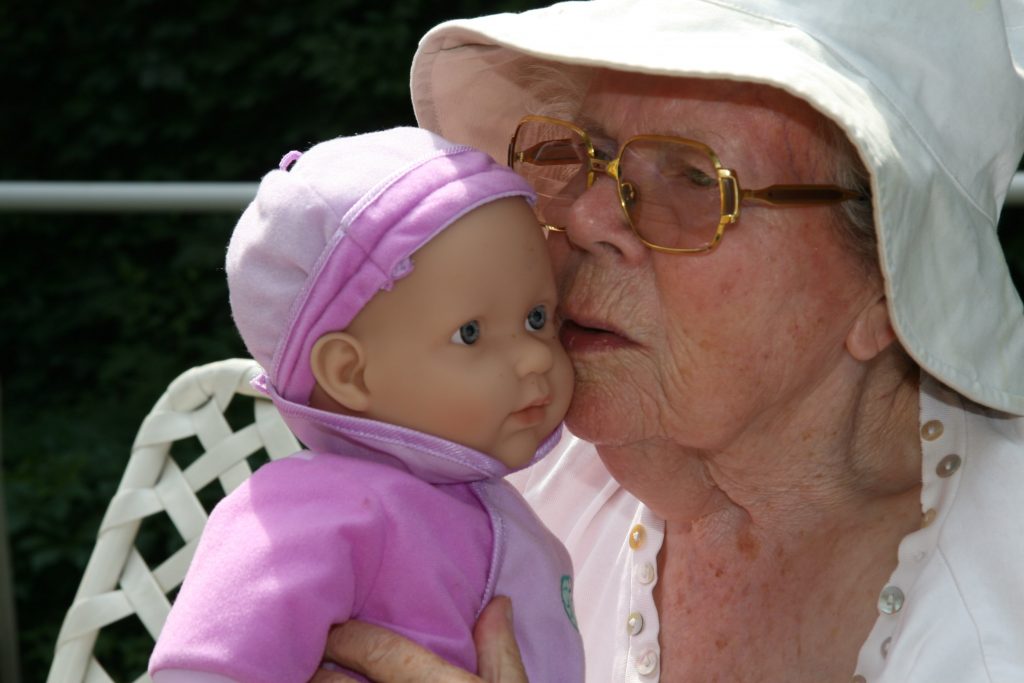
Over 50% of care home staff say their residents have dementia dolls, according to new research.
Dementia therapy dolls are on the rise and being used more frequently in care homes and one in ten staff revealing their residents use robotic therapy pets.
The research, carried out by carehome.co.uk, surveyed 2,491 care homes owners, managers and staff and found 72% believe there are positives to people with dementia using the dolls.
23% of those surveyed were ‘unsure’ whether the dolls provided a benefit, while 5% said they had no benefits at all.
Robotic therapy pet, which respond to touch, sound and provide stimulation and companionship are also getting popular in care homes, with one in 10 care home staff saying their care homes have them. Robotic therapy pets mimic real animals and include like-like dog noises and furry cats which meow and purr.
Sue Learner, editor for carehome.co.uk said: “To see your mum or grandma cuddling a doll and caring for it like a real baby can be very disturbing. But if the residents are getting comfort from this, it is good so many care homes are embracing this controversial therapy.
“People with dementia can be anxious and distressed and doll therapy has been found to be very calming. However to allay relatives’ concerns, it is important care homes fully explain what dolly therapy is and how it can help. Care for a doll or a robotic animal may make those with dementia feel needed and wanted and it may remind them of a time when they were a parent of a young child.
“There are cases where the person with dementia will forego food so they can feed their baby or sleep on the floor so the baby can have the bed. So the way they relate to the doll or robotic pet does need to be closely monitored.”
Experts in the field suggest a number of way for considering the therapy. These include gradually introducing, using the doll at certain times and ensuring people do not neglect their own needs in favour of the dolls.
Lynne Loughlin, senior activities coordinator at Barchester Iddenshall Hall and Beeston View Dementia Unit in Tarporley, uses the dolls for its residents with dementia. She said: “We have found they work really well. We don’t give them directly to the residents. We wait for the residents to approach the dolls themselves.
“They tend to think they are real and enjoy cuddling them and taking care of them. They like sitting with the dolls and talking to them. It offers them comfort and seems to give the residents a sense of calm.
“We have explained to the residents’ relatives and friends about the dolls and how they can bring a real sense of wellbeing for their loved ones with dementia. They have had no objections as they can see they work and the residents enjoy having them.”
Dr Gary Mitchell, who wrote ‘Doll Therapy in Dementia Care’ welcomed the findings from carehome.co.uk and said: “It is excellent to see a high percentage of care homes utilising the therapy in their practice. It is also encouraging that care homes are also utilising robotic therapy pets – this intervention builds on the same principles of attachment for which doll therapy works so well.
“The research has consistently demonstrated that doll therapy can have a life-changing impact for some people living with dementia by increasing levels of wellbeing and reducing need for behaviour modifying medication.
“While these interventions are very positive and the care homes who have introduced these innovative practices should be commended, I would always caution that provision of doll therapy or robotic pet therapy should never be a substitution for human contact. Instead the interventions should be incorporated into an already socially enriched day at the care home for the person living with dementia.”
